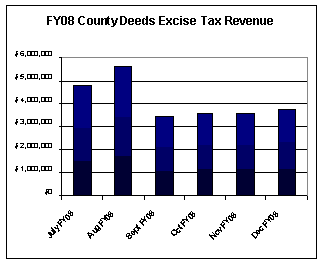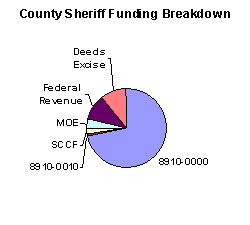County Sheriffs Transition
[ index ]
 FY2010 House 1 Budget Recommendation:
FY2010 House 1 Budget Recommendation:
Policy Brief
Deval L. Patrick, Governor
Timothy P. Murray, Lt. Governor
Governor's Proposal
Governor Patrick proposes to align the Massachusetts State and County Sheriffs under the state budgeting and finance laws. Massachusetts currently has 14 State and County Sheriffs that perform the same function, but operate under two different accounting systems. The 7 State Sheriffs operate under the state accounting system, including payroll, health care and retirement, while the 7 County Sheriffs continue to operate within a hybrid system that includes county, state and federal funding while using the county accounting system. Despite operating under the county accounting system, County Sheriffs receive 83% of their funding for operations the state and federal governments. In a companion bill to H.1, Governor Patrick proposes to reform the funding and accounting system for these 7 Sheriffs, which will provide consistency, transparency and efficiency in budgeting.
The volatility of the housing market has made the deeds excise revenues difficult to predict and to utilize as a stable funding source. Over the past year alone, deeds excise revenue has decreased by over 30%. The six month comparison charted below illustrates the volatility month to month for the first six months of fiscal year 2008 and fiscal year 2009. Given that county funding through deeds excise accounts for approximately 17% of the total County Sheriffs' funding, this unstable source of revenue has created year end deficiencies on an annual basis. This funding uncertainty prevents the Sheriffs from budgeting properly and prevents the state from gaining an accurate view of the fiscal situation of the Sheriffs and the Houses of Corrections. Transferring the County Sheriffs to the state system will allow all Sheriffs to know their annual appropriation for a given fiscal year and allow them to plan accordingly while taking advantage of the economies of scale that the state can offer.
Deeds Excise Tax Revenue Volatility - 2 Year Comparison


State Sheriffs
The seven State Sheriffs (Berkshire, Essex, Franklin, Hampden, Hampshire, Middlesex and Worcester) function under the constitutional arm of the government and receive a direct state appropriation in the budget. Their employees are state employees, receive state health and retirement benefits, and their operations utilize the state accounting, human resources, and payroll systems.
County Sheriffs
The seven County Sheriffs, (Barnstable, Bristol, Dukes, Nantucket, Norfolk, Plymouth, and Suffolk) are considered departments of the existing counties and receive their funding through 6 sources as allocated by the County Government Finance Review Board. The current funding sources include state General Fund appropriations for operations and Shattuck Hospital expenses; a percentage of the county deeds excise revenue and a County Maintenance of Effort (MOE) contribution; and federal revenue received for housing federal inmates.


Advantages of Reform
- Potential Cost Savings - Based on current estimates from Group Insurance Commission (GIC) and Public Employee Retirement Administration Commission (PERAC), the cost of providing these benefits will drop by $8-11 million once the transition is complete and operational. GIC and PERAC projected the health care and retirement costs savings by comparing their estimated costs to the current county projections. This estimate is based on fiscal year 2010 projections from the counties, GIC and PERAC.
- Greater Fiscal Stability for Current County Sheriffs - Under the current system, the budget for the county sheriffs is volatile during each fiscal year. The County Sheriffs are more susceptible to not reaching their funding goals because they are also dependent on local deeds revenue and county finances, which are affected by the overall economy.
- One State Sheriff System - The County Sheriffs would no longer be under an entirely different budget cycle and funding mechanisms. Having 14 State Sheriffs opens the door to further policy goals for all sheriffs, such as increasing economies of scale as one group, unifying public safety approach statewide, maximizing services for inmates statewide, standardizing all inmate data, and having a more coherent funding approach.
- Increased Oversight - Under a uniform system, the Executive Office for Administration and Finance (A&F) and the Legislature could track the expenses, revenue and personnel with greater detail. Under this scenario, all sheriffs would process their accounting through MMARS and place their employees in the HR/CMS system. These two steps would provide a greater understanding of their fiscal picture, and more accountability to state finance rules and regulations.
Mechanics
Each Sheriff will have a separate line item for the operation of his or her department and all employees will become state employees with state health insurance and pension benefits. Additionally, the County Corrections account (8910-0000) will be used to allocate the costs associated with health and retiree benefits to GIC and PERAC. All revenues previously collected by the county to fund the Sheriffs will now be deposited into the General Fund.
Prepared by the Executive Office for Administration and Finance · Rooms 373 & 272 · State House
For more information contact:
Michelle Small (michelle.small@state.ma.us)
www.mass.gov/budget/governor
 top of page
top of page
